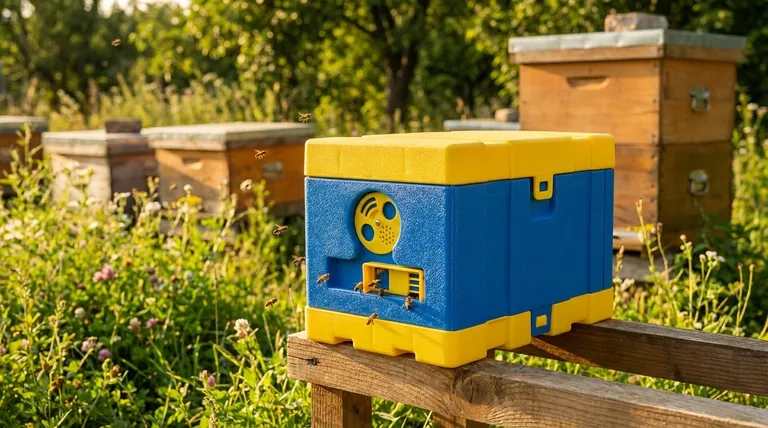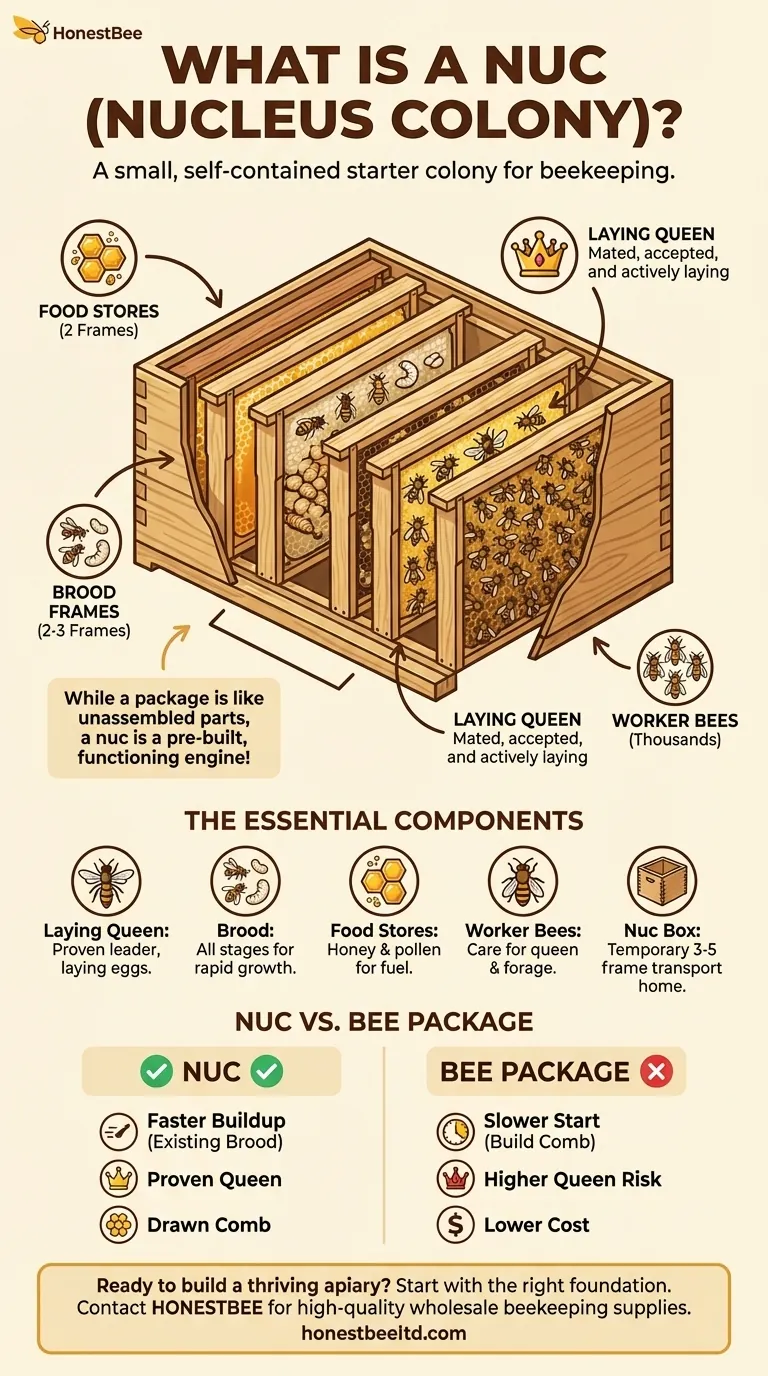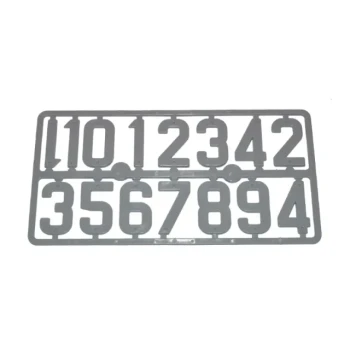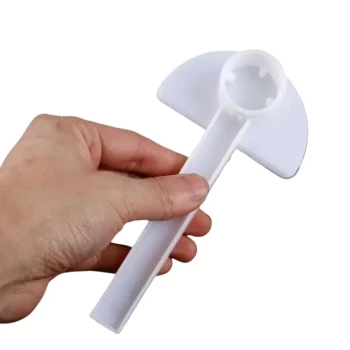In beekeeping, a nuc is a small, self-contained starter colony. It is short for a nucleus colony and contains all the essential elements of a full-sized hive but in a smaller, more manageable form. A typical nuc includes a laying queen, thousands of worker bees, and several frames of both brood (developing bees) and food (honey and pollen).
While a package of bees is like a box of unassembled parts, a nuc is a pre-built, functioning engine. It gives a new beehive a significant head start by providing an already established colony structure, a proven queen, and drawn comb.

What Defines a Nucleus Colony?
A nuc is fundamentally a miniature, functioning beehive. It is sold as a complete, integrated unit, which is its primary advantage for beekeepers looking to start a new hive or expand their apiary.
More Than Just Bees: A Complete System
Unlike a bee package, which is a crate of loose bees with a caged queen, a nuc is a working social organism. The bees are already familiar with their queen and have established routines for foraging, nursing brood, and defending the colony.
The Essential Components
Every healthy nuc must contain four critical elements:
- A Laying Queen: The queen is mated, accepted by the colony, and actively laying eggs. This is non-negotiable.
- Brood: The frames will contain brood in all stages—eggs, larvae, and capped pupae—which guarantees the colony's population will grow rapidly.
- Food Stores: At least one or two frames will be filled with honey for energy and pollen for protein, providing the fuel the colony needs to expand.
- Worker Bees: A population of several thousand adult bees is present to cover the frames, care for the queen and brood, and forage for resources.
The Nuc Box: A Temporary Home
These components come housed in a small, temporary box, typically made of wood or corrugated plastic, that holds three to five frames. This box is used for transport and to house the colony until it is transferred into a full-sized hive.
A Closer Look Inside a Standard 5-Frame Nuc
While nucs can come in different sizes, the five-frame configuration is the most common industry standard. The exact ratio of brood to food can vary slightly by supplier, but the purpose of each frame is distinct.
The Brood Frames: The Engine of the Hive
Typically, two to three frames are dedicated to brood. Seeing a solid pattern of eggs, larvae, and capped cells is a clear sign of a healthy, productive queen and a colony poised for rapid growth.
The Food Frames: Fuel for Expansion
The remaining two frames are primarily dedicated to food. These frames of honey and pollen ensure the colony has the resources to draw out new comb and feed its expanding population, especially if there is a temporary lack of available nectar.
The Queen: A Proven Leader
The most valuable aspect of a nuc is its proven queen. Because she is already integrated and laying, the risk of the colony rejecting her—a common problem with bee packages—is virtually eliminated. You are starting with a known-good leader.
Understanding the Trade-offs: Nuc vs. Bee Package
For a new beekeeper, the choice often comes down to starting with a nuc or a bee package. Each has clear advantages and disadvantages.
The Nuc's Advantage: A Proven Head Start
A nuc provides an undeniable advantage in buildup speed. With drawn comb and developing brood already present, a nuc can expand into a full-sized hive weeks faster than a package, potentially producing a honey surplus in its first year.
The Nuc's Disadvantages: Cost and Availability
This head start comes at a price. Nucs are more expensive and heavier than packages, making them more difficult to ship long distances. They are often only available for local pickup from bee producers.
The Package's Advantage: Cost and Flexibility
Bee packages are cheaper and can be shipped across the country. They offer a "blank slate," allowing the beekeeper to start the colony on their own equipment from day one, which can be useful for managing diseases or using specific foundation types.
The Package's Disadvantage: Higher Risk and Slower Start
The primary drawback of a package is the risk associated with queen introduction. The colony must accept the new queen, and she must begin laying successfully. The bees also have to build all their wax comb from scratch, a process that consumes enormous energy and time.
Making the Right Choice for Your Goal
Ultimately, the best choice depends on your priorities as a beekeeper.
- If your primary focus is a successful start with less risk: Choose a nuc for its established queen and existing brood, which ensures a faster and more reliable colony buildup.
- If your primary focus is lower initial cost and you are comfortable with more hands-on management: A bee package is a viable option, but be prepared for the challenges of queen introduction and the slower process of building comb.
Understanding these fundamentals empowers you to select the right foundation for a thriving apiary.
Summary Table:
| Component | Purpose & Details |
|---|---|
| Laying Queen | Mated, accepted, and actively laying eggs. A proven leader for the colony. |
| Brood Frames (2-3) | Contains eggs, larvae, and capped pupae to ensure rapid population growth. |
| Food Frames (2) | Frames of honey and pollen to fuel colony expansion and comb building. |
| Worker Bees | Several thousand adult bees to care for the brood and forage. |
| Nuc Box | A temporary 3-5 frame box for transport and housing before transfer to a full hive. |
Ready to build a thriving apiary with the right foundation?
Starting with a strong nucleus colony is one of the most effective ways to ensure success. At HONESTBEE, we specialize in supplying high-quality beekeeping supplies and equipment to commercial apiaries and distributors through our wholesale-focused operations.
We understand that a reliable start is critical for your business's growth and productivity. Let us provide you with the durable equipment and resources you need to support your nucs and expanding colonies.
Contact our expert team today to discuss your wholesale needs and how we can help your operation succeed.
Visual Guide

Related Products
- 4 Frame Plastic Nuc Boxes for Beekeeping Bee Nuc Box
- HONESTBEE Professional Long Handled Hive Tool with Precision Cutting Blade
- Multi-Function Plier-Style Frame Grip Hive Tool
- Professional Multi-Function Stainless Steel Hive Tool
- Modern Flat-Mount Hive Number Set for Beekeeping
People Also Ask
- What are some uses for a nucleus in beekeeping? A Guide to Apiary Growth and Resilience
- How many bees are in a nucleus hive? Get a Head Start with 10,000-15,000 Bees
- Why is a sound knowledge of beekeeping basics important when working with nuclei? Unlock Your Apiary's Full Potential
- What are the benefits of maintaining a nuc in beekeeping? Gain Control and Resilience for Your Apiary
- What should a healthy brood nest in a nuc look like? A Guide to Strong Colony Development



















